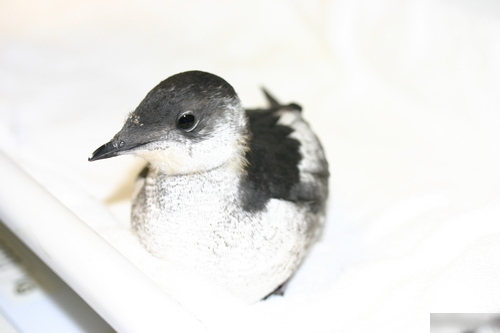Eastern Sierra Fish Report
Saltwater Fish Report for 6-30-2009
Saltwater Fish Report for 6-30-2009
CDFG Releases: Rare Marbled Murrelet Fledgling

by Marine Management News
6-30-2009
(916) 322-8639
Website
Contact:
Dr. Dave Jessup, DFG Wildlife Veterinarian, 831-469-1726
Carol Singleton, DFG Communications Office, 916-327-9948
A tiny bird found by a little girl near a Santa Cruz beach turned out to be a rare species, amazing and delighting California bird biologists.
According to the Department of Fish and Game (DFG), a young girl discovered the bird June 26 in the woods at Ano Nuevo State Park in Santa Cruz County.
Along with her parents, she reported the find to State Park Chief Ranger Gary Strachan, who immediately recognized the bird as a fledgling marbled murrelet. The murrelet is listed as threatened under the Endangered Species Act.
Studies have estimated that only 2,000 murrelets remain in California and Oregon. Their numbers have plummeted over the past decade due to destruction of habitat, predation, gill nets and other factors. Biologists know that small murrelet populations have been struggling for survival in the redwood and conifer forests in Santa Cruz and southern San Mateo counties, as well as further north in Humboldt County, but they are very rarely seen. The discovery of a baby marbled murrelet is particularly unusual; the last time it happened at Ano Nuevo was the mid 1990s.
Strachan brought the bird to DFG's Marine Wildlife Veterinary Care and Research Center in Santa Cruz, where Dr. Dave Jessup and his staff evaluated the fledgling and found it to be in generally good health.
Although they spend most of their lives at sea, murrelets nest high in the branches of trees found in California's old-growth forests, which grow inland, far away from where they feed. Mating pairs lay just one egg a year. Once the fledglings are ready to leave the nest, they fly with their parents to the sea - which can be as far as 50 miles away - to feed for the first time. Jessup said he suspects that the baby bird became separated from its parents on this first crucial flight.
After consulting with DFG seabird experts Esther Burkett and Laird Henkel, as well as representatives from the U.S. Fish and Wildlife Service, Dr. Jessup decided that the fledgling was not in need of long-term care or rehabilitation and should be released with minimal human intervention, thus increasing its chances of successfully reuniting with its parents.
DFG kept the bird overnight and hand-fed it as much as it could eat in order to prepare it for release. The U.S. Geological Survey also banded the little bird - a task that is usually very difficult with this elusive species.
Early on June 27, under the cover of the morning mist, the young bird was released at Ano Nuevo Beach. It promptly dove under the water and resurfaced seconds later, appearing to be quite at home in its ocean habitat.
Photos
< Previous Report Next Report >
< Previous Report Next Report >
More Reports

6-30-2009
Wildlife, Water, Energy Issues to be Examined at Annual Fish and Wildlife Meeting Contact: Kirsten Macintyre, DFG Communications, (916) 322-8911 Wildlife experts from...... Read More

6-27-2009
It has been a full year since we embarked upon the south coast marine protected area (MPA) planning process, where...... Read More

www.EasternSierraFishReports.com © 2025. All Rights Reserved.
Website Hosting and Design provided by TECK.net
Website Hosting and Design provided by TECK.net
